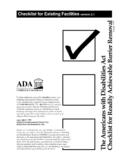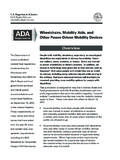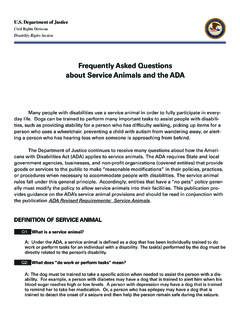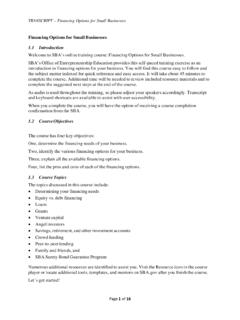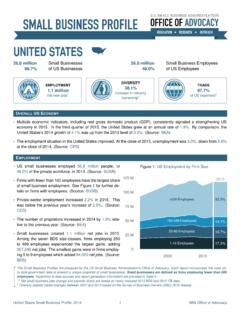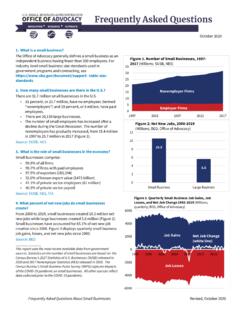Transcription of ADA Guide for Small Businesses
1 Americans with Disabilities ActADA Guide for Small Department of JusticeCivil Rights Small Business AdministrationOffice of Entrepreneurial DevelopmentiThe ADA authorizes the Depart-ment of Justice to provide techni-cal assistance to individuals andentities that have rights or respon-sibilities under the Act. Thisdocument provides informalguidance to assist you in under-standing the ADA and theDepartment's regulation. How-ever, this technical assistance doesnot constitute a legal interpretationof the Authorization #99-2111-26fourth printing, June 1999 DisclaimerReproductionReproduction of this document Small Business Administration is pleased to work with the U.
2 S. Department of Justice inassisting Small Businesses to understand and comply with the Americans With Disabilities of ContentsIntroduction .. 1 The Americans with Disabilities Act .. 1 Businesses that Serve the Public: Public Accommodations .. 2 Existing Facilities .. 2 Architectural Barriers .. 3 Removing Architectural Barriers .. 3 Priorities for Barrier Removal .. 3 Examples of Barrier Removal .. 3 Accessible Parking .. 4 Accessible Entrance .. 6 Doors at Entrances to Businesses .. 8 Turnstiles and Security Gates at Entrances.
3 8 Shelves and Maneuvering Space .. 10 Sales and Service Counters .. 11 Serving Counters .. 12 Fixed Seating and Tables .. 13 Policies and Procedures .. 14 Communicating with Customers .. 14 Tax Credits and Deductions .. 14 New Construction and Alterations .. 15 ADA Information Sources .. 15iii1To get answers to questionsabout the ADA orto learn more about the lawcall theDepartment of JusticeADA Information Line,toll-free(1-800-514-0301 voice and1-800-514-0383 TDD).This Guide presents an informaloverview of some basic ADArequirements for Small businessesthat provide goods or services tothe public.
4 It omits many of the legal terms that are found in theADA and its regulations. Butbecause it would be misleading toseparate any explanation of ADArequirements from the law, refer-ences to key sections of the regula-tions or other information Americans with DisabilitiesAct (ADA) is a Federal civil rightslaw that prohibits the exclusion ofpeople with disabilities fromeveryday activities, such as buyingan item at the store, watching amovie in a theater, enjoying a mealat a local restaurant, exercising atthe local health club or having thecar serviced at a local garage.
5 Tomeet the goals of the ADA, the lawestablished requirements forprivate Businesses of all requirements first went intoeffect on January 26, 1992, andcontinue for both for-profit andnon-profit Small Businesses , compliancewith the ADA is not difficult. Tohelp Businesses with their compli-ance efforts, Congress establisheda technical assistance program toanswer questions about the to your questions aboutthe ADA are a phone call Department of Justice oper-ates a toll-free ADA InformationLine (800- 514-0301 voice and800-514-0383 TDD).
6 In addition,tax credits and deductions wereestablished that can be usedannually to offset many costs ofproviding access to people recognition that many smallbusinesses can not afford to makesignificant physical changes totheir stores or places of business toprovide accessibility to wheelchairusers and other people withdisabilities, the ADA has require-ments for existing facilities builtbefore 1993 that are less strict thanfor ones built after early 1993 ormodified after early Americans with Disabilities ActIntroduction2 Private Businesses that Serve the Public: Public AccommodationsPrivate Businesses that providegoods or services to the public arecalled public accommodations inthe ADA.
7 The ADA establishesrequirements for twelve categoriesof public accommodations, includ-ing stores and shops, restaurantsand bars, service establishments,theaters, hotels, recreation facili-ties, private museums and schoolsand others. Nearly all types ofprivate Businesses that serve thepublic are included in the catego-ries, regardless of you own, operate, lease, or leaseto a business that serves the public,then, you are covered by the ADAand have obligations for existingfacilities as well as for compliancewhen a facility is altered or a newfacility is constructed.
8 Existingfacilities are not exempted by"grandfather provisions" that areoften used by building accomplishable withoutmuch difficulty or expense. The readily achievable requirement isbased on the size and resources ofthe business. So larger businesseswith more resources are expectedto take a more active role inremoving barriers than smallbusinesses. The ADA also recog-nizes that economic conditionsvary. When a business has re-sources to remove barriers, it isexpected to do so; but when profitsare down, barrier removal may bereduced or delayed.
9 Barrierremoval is an ongoing obligation --you are expected to removebarriers in the future as resourcesbecome FacilitiesMany business facilities were builtwithout features that accommodatepeople with disabilities, includingpeople who use wheelchairs. Thislack of accessibility makes itimpossible for many people withdisabilities to take part in everydayactivities such as going to work,eating in a restaurant or shoppingin a store. The ADA recognizesthat, for people with disabilities toparticipate in the everyday activi-ties in their communities, theyneed to have access to the goodsand services provided by it is not possible for manybusinesses, especially smallbusinesses, to make their facilitiesfully accessible, there is much thatcan be done without much diffi-culty or expense to improveaccessibility.
10 Therefore, the ADArequires that accessibility beimproved without taking onexcessive expenses that couldharm the you own or operate a businessthat serves the public you mustremove physical barriers that are readily achievable, which meansThis booklet focuses onbusinesses that providegoods and servicesto the Businesses may belarge or Small and can befor profit or awning and awning support overthe walk to the entrance is too close tothe ground and is a barrier to peoplewho are blind or visually parking spaces are too narrowand lack a wide access aisle so peoplewho use wheelchairs cannot get out oftheir step at the entrance can stoppeople from visiting your BarriersIn evaluating what barriers need tobe removed.

